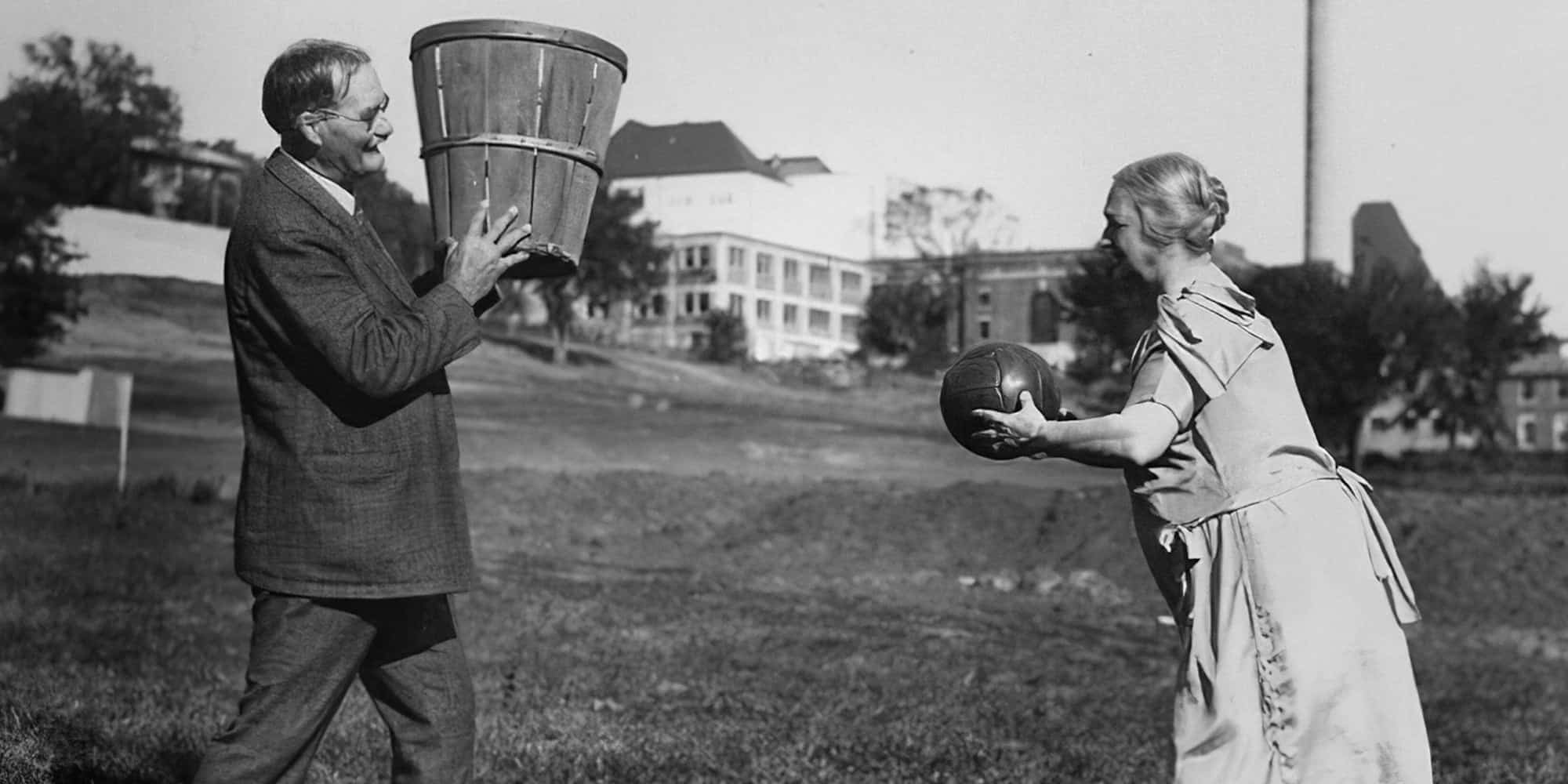Basketball is a game where the objective is to score more points than the opposing team. As simple as that sounds, sometimes the jargon used in the sport can be a little confusing for casual fans.
Take the field goal, for instance. Anyone who is watching a televised NBA or college basketball game for the first time may scratch their heads when they hear the term “field goal”.
We generally understand that a ‘goal’ in any ball sport is where we want the ball to end up. So right off the bat, we can assume that it has something to do with the ball entering the hoop, which is sometimes referred to as a basketball goal.
Aha! Is the term used to describe a player making a basket? Basically yes, but it’s a little more nuanced.
Field Goal Definition
Let’s start by defining exactly what a field goal is.
Simply put, a basketball field goal is any basket scored by a player, excluding free throws. It can also be defined as a basket scored when the ball is live and the shot clock is running (because the shot clock is stopped during free throws).
Why is it called a Field Goal?
The term ‘field goal’ sounds strange to many. Unlike American Football, a basketball game is played on a court, not a field. And unlike soccer, you don’t hear commentators yelling ‘beautiful goal!’ after a player scores.
A likely explanation is that basketball was played on grass in the early days, shortly after James Naismith invented the game in 1891.
This was true; many schools played the game on grass, often for lack of a suitable indoor facility. In the early days, emphasis was on passing and shooting, and dribbling was not a focal part of the game. Even when played indoors, dribbling was awkward because the balls didn’t bounce as well as they do now.
Fun fact: Outdoor basketball was especially popular among women, giving birth to the game of Netball in England—a game where you can’t dribble the ball.
Whatever the explanation, it’s likely that this ancient basketball term simply never changed to become something more appropriate for today’s game.
How Many Points Are Field Goals Worth?
Field goals are either worth two or three points. Anything scored inside the three-point arc is worth two points. They could be layups, floaters, elbow jumpers, or something else; all of these shots are field goals worth two points.
On the other hand, any made shot beyond the rainbow arc (three-point line) is worth three points. It doesn’t matter if the three-point shot attempt is from the logo or the whole 94 feet; it’s considered a three-point field goal if the player makes that shot.
This scoring system is always the case in standard 5-on-5 basketball rules. However, different scoring systems can be found in the FIBA 3×3 and BIG3 rulebooks. FIBA 3X3 competitions score one and two-point field goals (replacing the two-point and three-point field goals, respectively). The BIG3 league literally takes it a step further by introducing a four-point field goal.
Shots That Count As Field Goals
In basketball, the level of difficulty may elicit cheers from fans, but it wouldn’t add points to a made basket. The only thing that matters is where you shot the ball from. Here are some of the shots that count as field goals:
- Layup: A two-point shot attempt made by laying the ball near the basket. The player may bounce it off the backboard or straight to the bucket.
- Slam Dunk: No matter how crazy ridiculous the degree of difficulty is, slamming the ball into the hoop is worth just two points.
- Tip-Ins: A tip-in is when an offensive player taps the ball into the basket after a miss. It is still worth two points.
- Floaters and runners: When a player releases the ball over the top to prevent the defender from blocking the shot. Sometimes, it is referred to as the “teardrop.”
- Jump Shot: A basic shooting technique in which a player shoots the ball from a straight vertical jump towards the basket. Jump shots are worth two or three points, depending on the distance.
- Hook Shot: A hook shot is a type of basketball shot in which an offensive player throws one arm over their head sideways in a hooking motion to score. It has a lot of variations, but the skyhook is the one made famous by Kareem Abdul-Jabbar.
- Bank shot: Any shot where the ball bounces off the backboard before going into the basket.
Because there are so many different ways to score a field goal in basketball, most players specialize in shooting from one or two areas on the court. However, versatile players can score from anywhere: around the rim, midrange, and 3-point range. They are often referred to as three-level scorers, but that’s a story for another day.
Why isn’t a free throw considered a field goal?
A field goal is any shot that is scored while the game is still being played rather than being stopped because of a foul. The term is significant precisely because it is used to describe a shot that wasn’t scored from a free throw.
Basketball has a pretty interesting rule regarding field goals and free throws. If a player is fouled in the act of shooting and did not make the shot, he won’t be charged a field goal attempt. He will be given two free throws, but the field goal attempt is not recorded. The field goal will only be listed only if he made the shot.
If a player on offense is fouled while shooting a three-point shot and makes it, the shot is counted as a three-point field goal, and the player is also given one free throw.
What is the field goal percentage (FG%) statistic?
Field goal percentage is considered one of the most critical individual statistics in basketball. Players with a high field goal percentage combined with shooting volume are usually among the top scorers.
Field goal percentage (FG%) is calculated by dividing the field goals scored by the field goal attempts and then multiplied by 100 to get a percentage.
For example, if Nikola Jokic scored 10 baskets out of 15 field goal attempts, his FG% is 66.7% rounded to the nearest decimal.
When determining FG%, two-point and three-point attempts are both weighted equally. However, the effective field goal percentage (eFG%) statistic gives three-point field goals more weight than two-point field goals.
Field Goal Shot Difficulty
During a basketball game, it’s not uncommon to hear the commentators talk about “high-percentage” and “low-percentage” field goal attempts.
High-percentage looks are shots that have the highest chance of going in, primarily because they are taken close to the rim. Examples of high-percentage field goal attempts are layups and dunks.
Conversely, low-percentage shots are field goal attempts with a low probability of going in. A contested jump shot from the three-point area is considered a low-percentage look.
As a coach, you recognize that it’s impossible for the team to make all of their shots. What you want is a steady diet of open looks to increase the chances of making shots. Unless you’re Kobe Bryant or Michael Jordan, well-guarded shots are the most difficult to make in basketball.
Why Field Goal Statistics Are Important
Calculating field goal percentage (FG%) and the effective field goal percentage (eFG%) can be incredibly valuable. They give us a way to measure a basketball player’s efficiency, and ultimately determine how good a player is playing offense.
The number of field goals made and the percentage of field goals made is essential factors in determining how efficient a player is.
Because there are so many different ways to score a field goal in basketball, most players excel in one or two. However, the best players can score in a variety of ways. They are often referred to as three-level scorers, but that’s a story for another day.
All-Time NBA Field Goal Record Holders
Most Field Goals
- Kareem Abdul-Jabbar (15,837)
- LeBron James (13,543)
- Karl Malone (13,528)
- Wilt Chamberlain (12,681)
- Michael Jordan (12,192)
Highest Career FG%
- DeAndre Jordan (67.3%)
- Rudy Gobert (65.3%)
- Clint Capela (62.4%)
- Montrezl Harrell (62%)
- Artis Gilmore (60%)
Most Field Goals In A Single Game
- Wilt Chamberlain (36 FGM once)
- Wilt Chamberlain (31 FGM once)
- Rick Barry (30 FGM once)
- Wilt Chamberlain (30 FGM once)
- Wilt Chamberlain (29 FGM four times)
- Kobe Bryant (28 FGM once)
- David Thompson (28 FGM once)
Most Field Goals Made Without A Miss
- Wilt Chamberlain (18 FGM, once)
- Wilt Chamberlain (16 FGM, once)
- Wilt Chamberlain (15 FGM, once)
- Thomas Bryant (14 FGM, once)
- Gary Payton (14 FGM, once)
- Billy McKinney (14 FGM, once)
- Wilt Chamberlain (14 FGM, once)
- Bailey Howell (14 FGM, once)
Single Season FG% Record
- Mitchell Robinson – 74.2% (2019-20)
- Wilt Chamberlain – 72.7% (1972-73)
- DeAndre Jordan – 71.4% (2016-17)
- Rudy Gobert – 71.3% (2021-22)
- DeAndre Jordan – 71% (2014-15)
Final Thoughts
For many, the offense is the most exciting part of basketball. You can’t blame them; after all, a team wins by outscoring opponents. With that being said, there are only two ways to score in basketball—field goals and free throws.
If you’re relatively new to basketball, you may expand your knowledge by learning more about the types of field goals and what makes a field goal attempt low or high percentage. It’s nerdy basketball stuff, but hey, it’s all about the love of the game.

